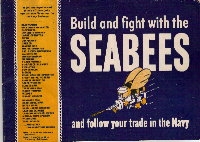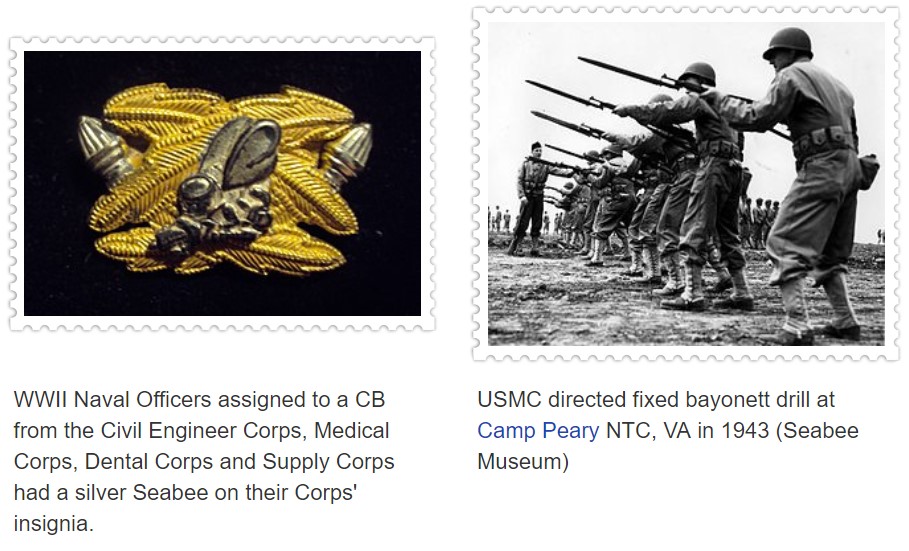


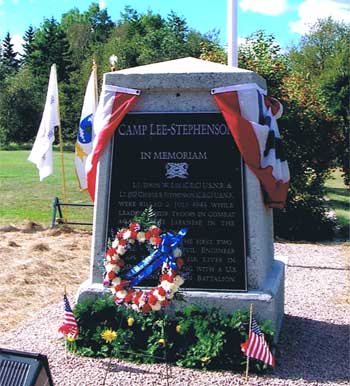
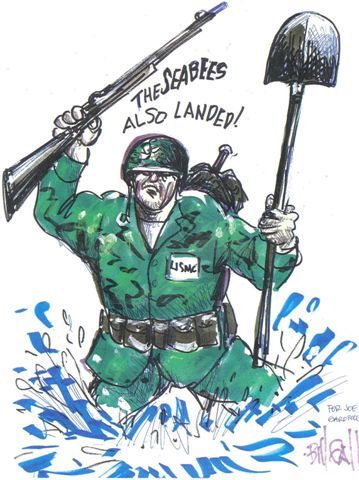 The
famous New York Daily News cartoonist and former WW2 Marine Bill Gallo made
this drawing for a WW2 Seabee friend. They first met in a cave on Saipan.
The
famous New York Daily News cartoonist and former WW2 Marine Bill Gallo made
this drawing for a WW2 Seabee friend. They first met in a cave on Saipan.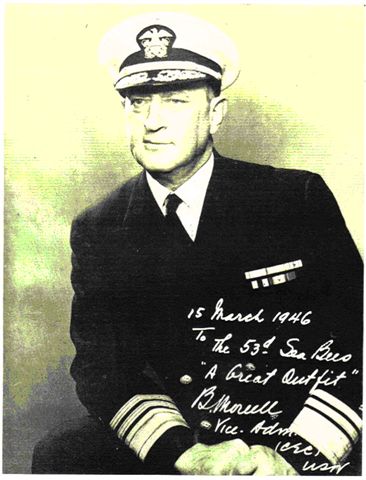
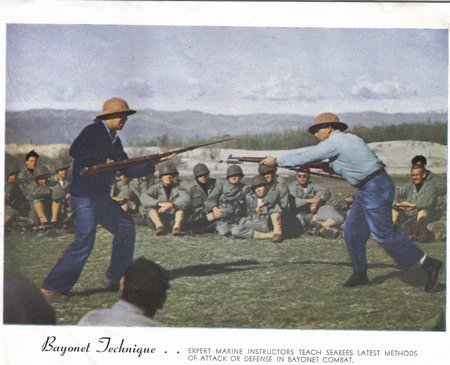
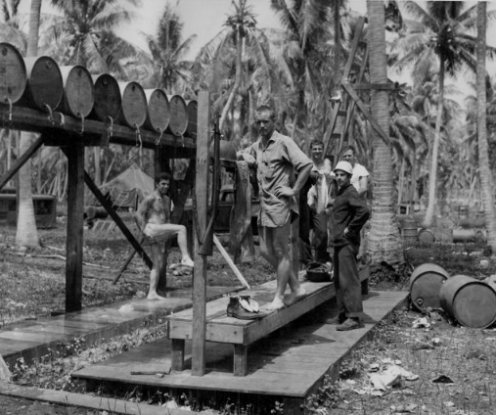


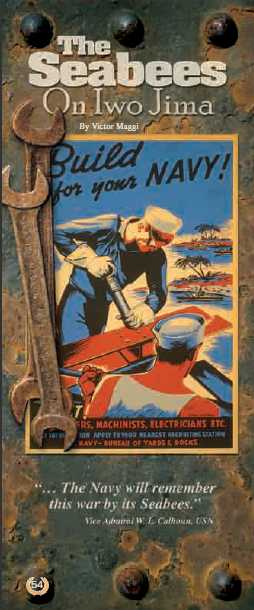 ALFRED H. TESHEE, 133RD N.C.B. IWO-JIMA. 2/19/45
ALFRED H. TESHEE, 133RD N.C.B. IWO-JIMA. 2/19/45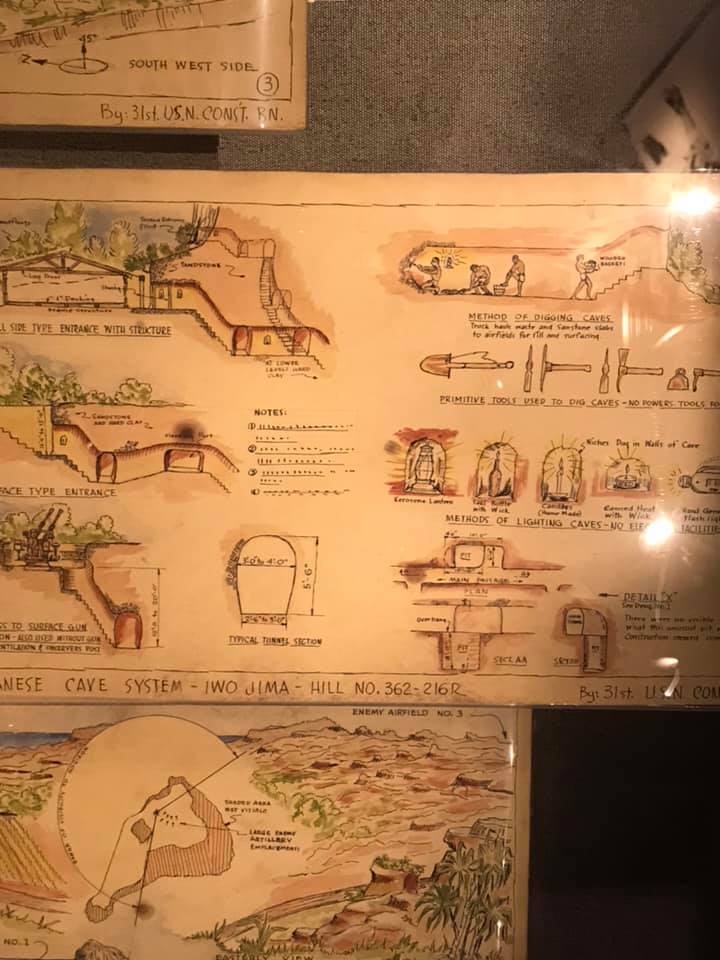


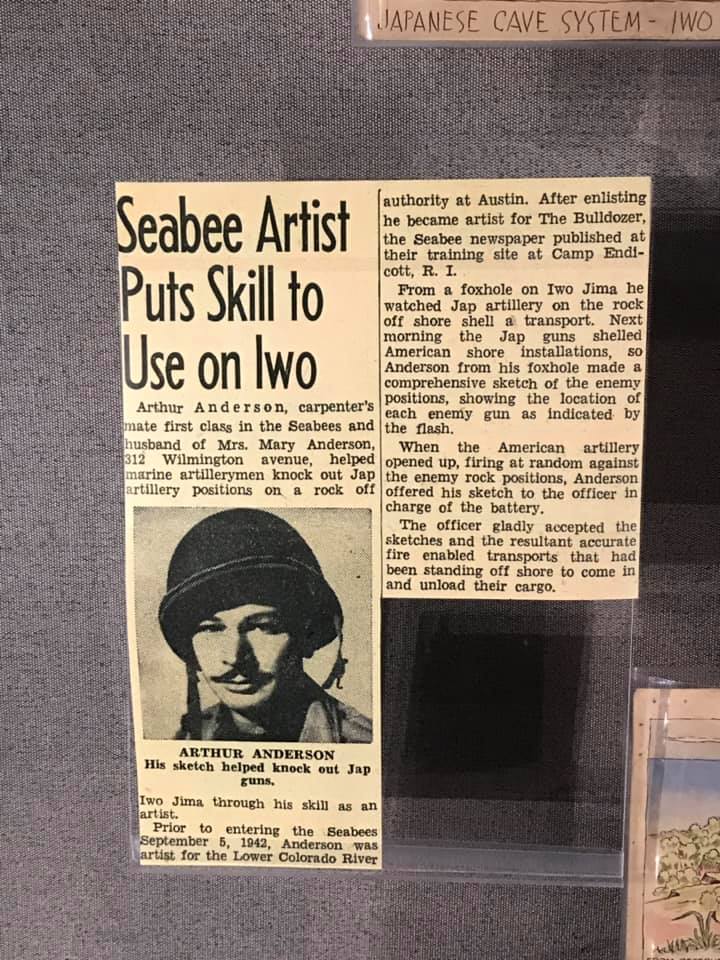
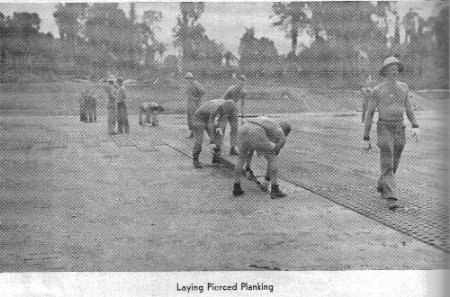

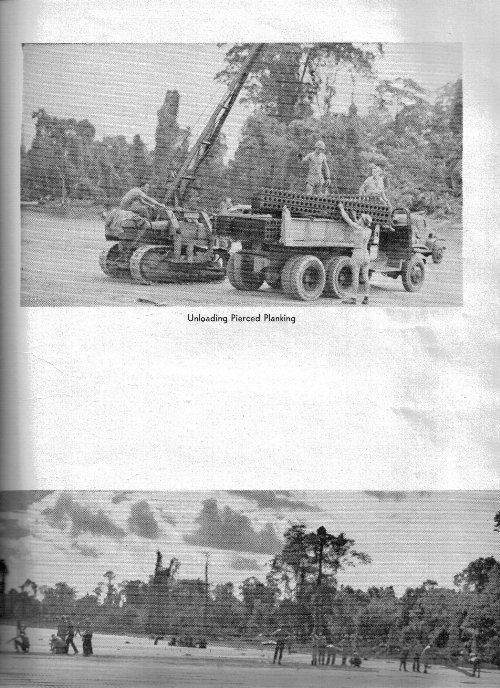
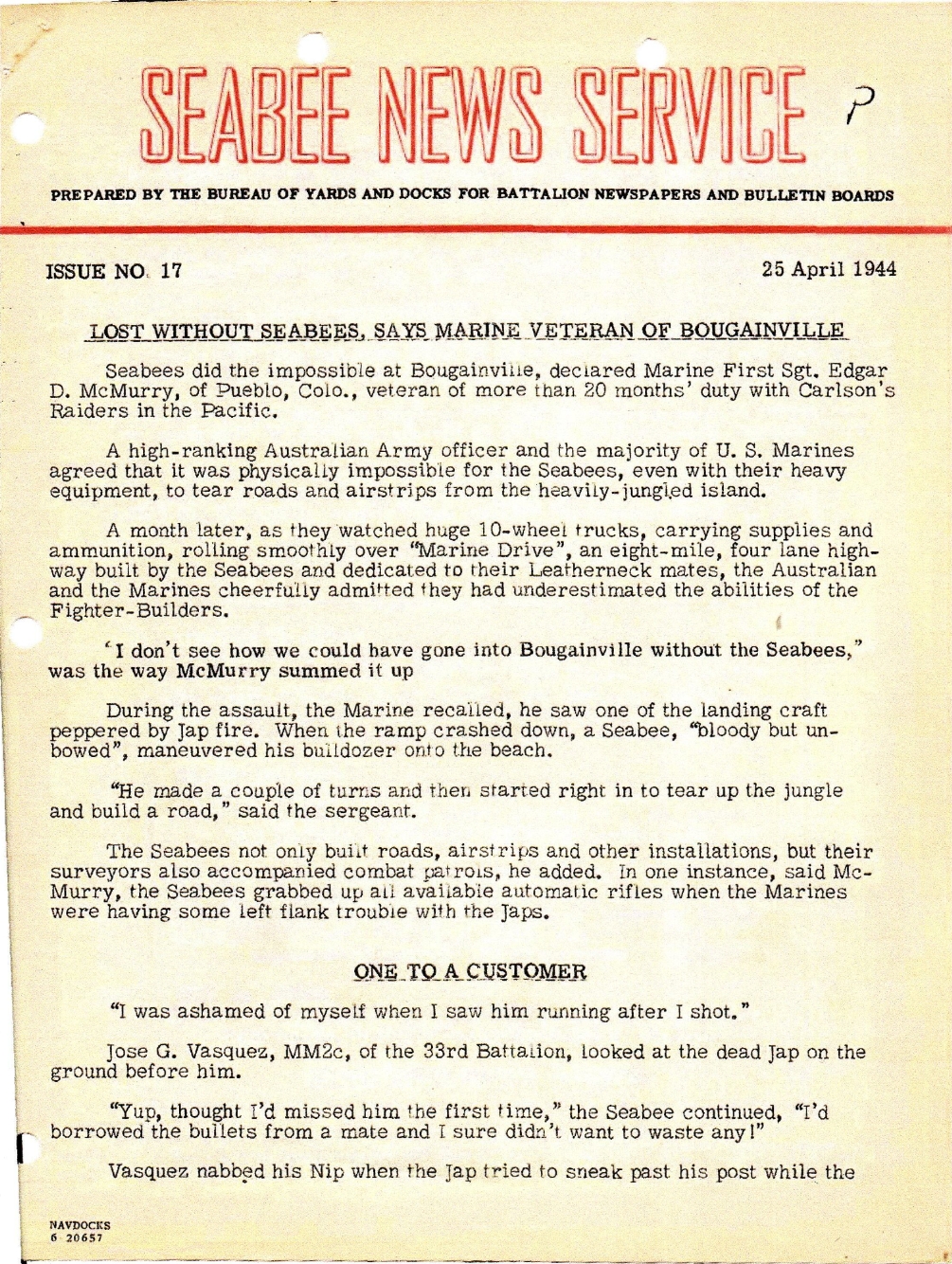





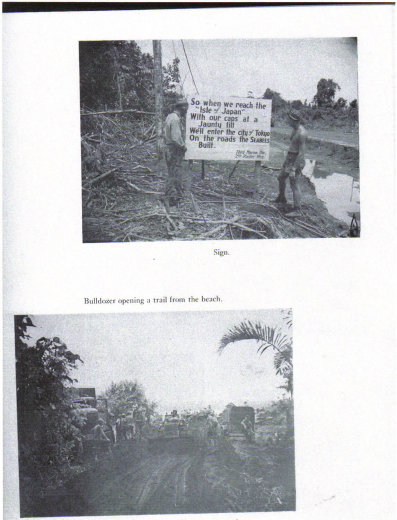



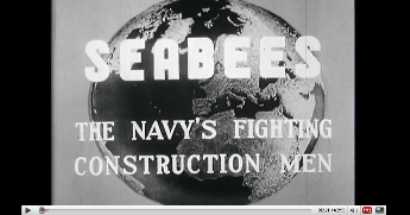
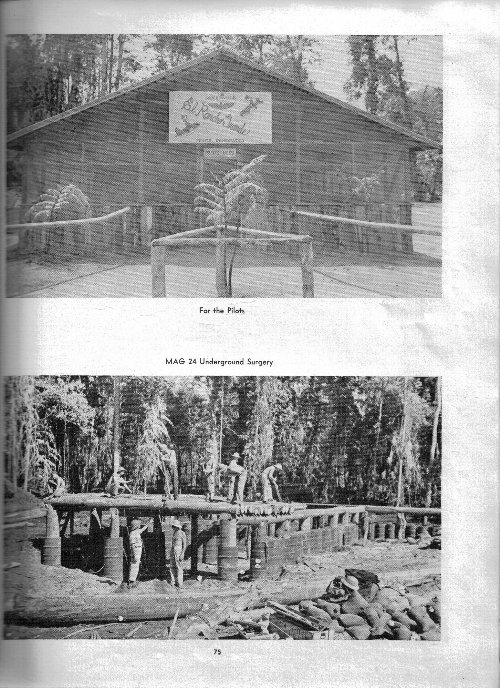
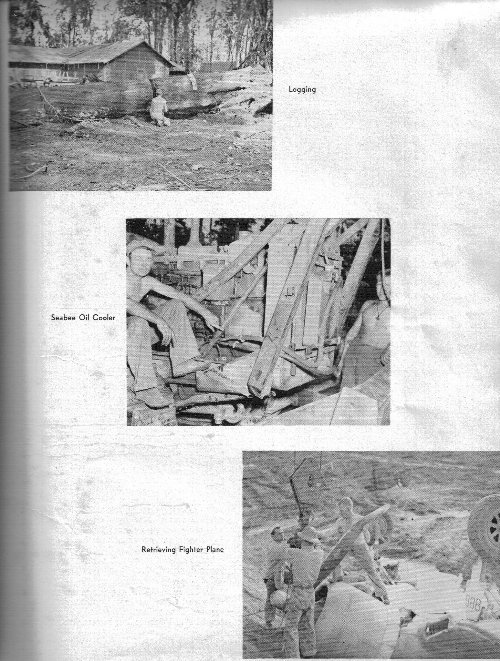 This picture shows what down to earth homespun Seabees
did in the 1940's, and it still works today. The middle picture shows two
Seabees with an island made replacement engine oil cooler on a Caterpillar
D-8. These Seabees added a radiator from a truck for the replacement engine
oil cooler. The air moving through the engine oil cooler was forced by the
engine fan. Classic Seabee !!!!!
This picture shows what down to earth homespun Seabees
did in the 1940's, and it still works today. The middle picture shows two
Seabees with an island made replacement engine oil cooler on a Caterpillar
D-8. These Seabees added a radiator from a truck for the replacement engine
oil cooler. The air moving through the engine oil cooler was forced by the
engine fan. Classic Seabee !!!!! 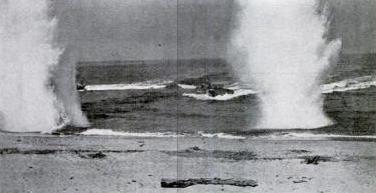

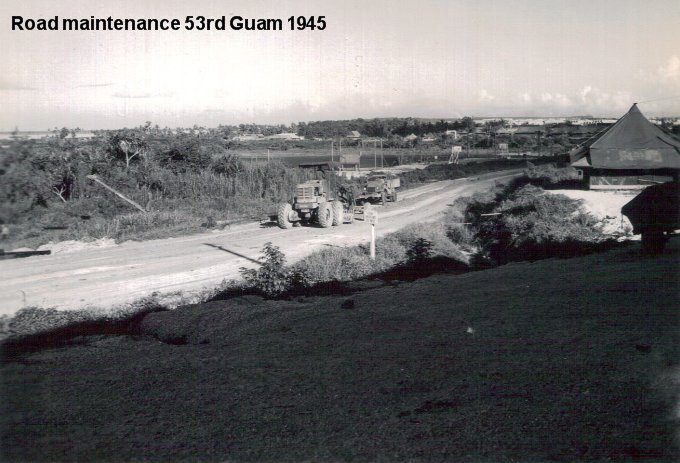
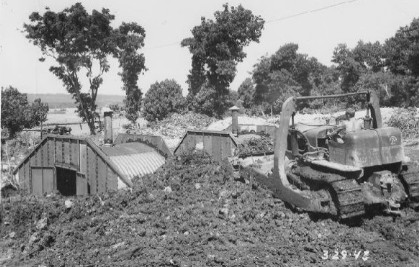
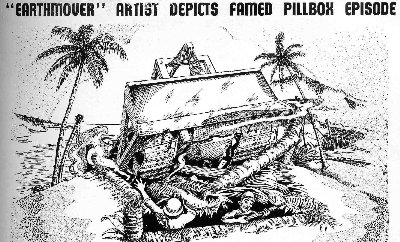
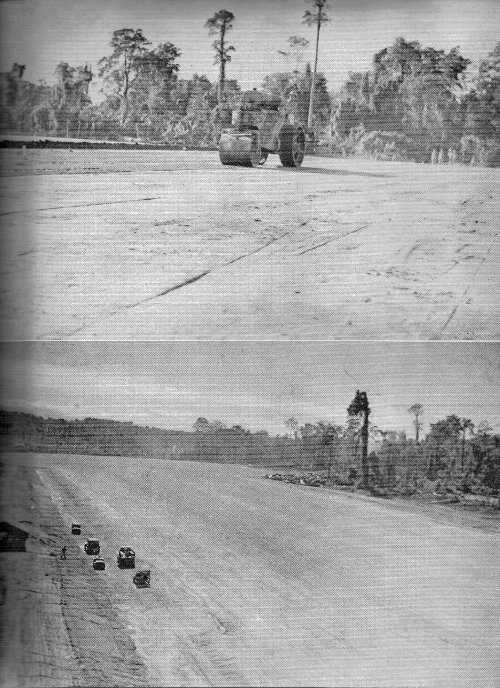

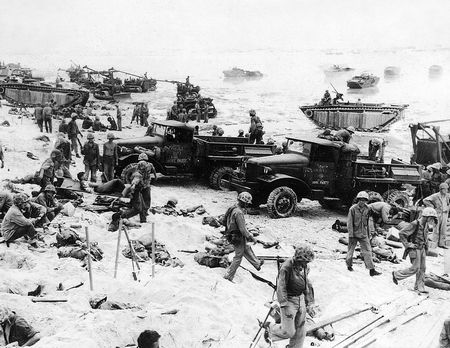

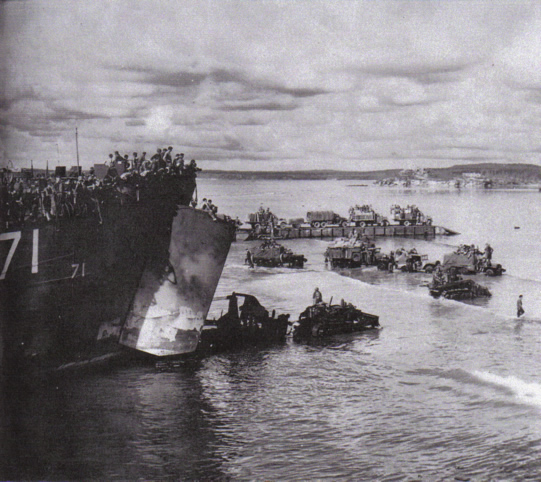
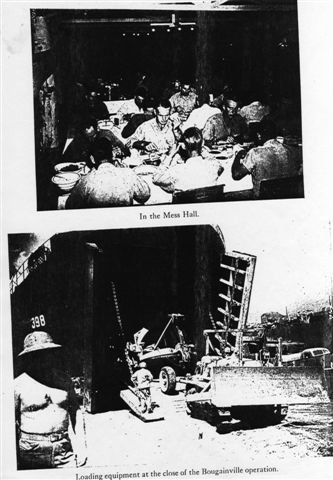 Bottom
picture is a Allis-Chalmers HD-14 loading a LeTourneau "LS" carryall on a
LST.
Bottom
picture is a Allis-Chalmers HD-14 loading a LeTourneau "LS" carryall on a
LST. 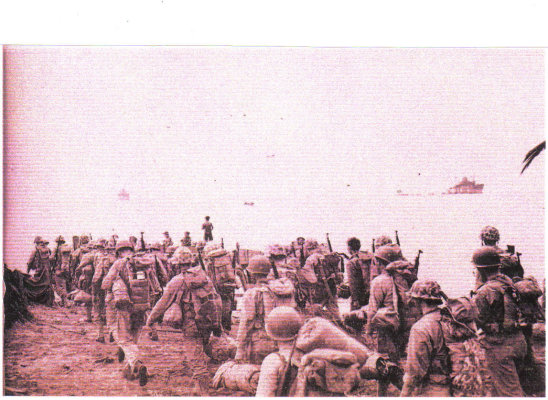 The
53rd Leaving Guadalcanal for the Bougainville campaign.
The
53rd Leaving Guadalcanal for the Bougainville campaign.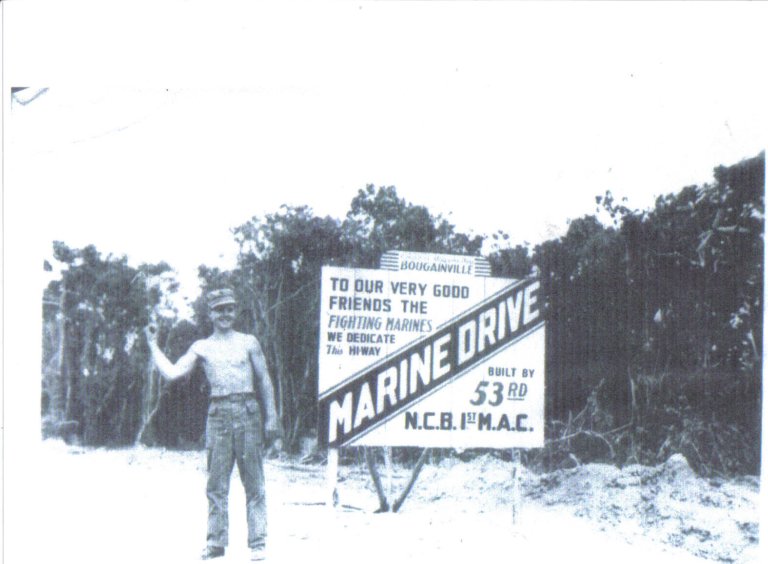
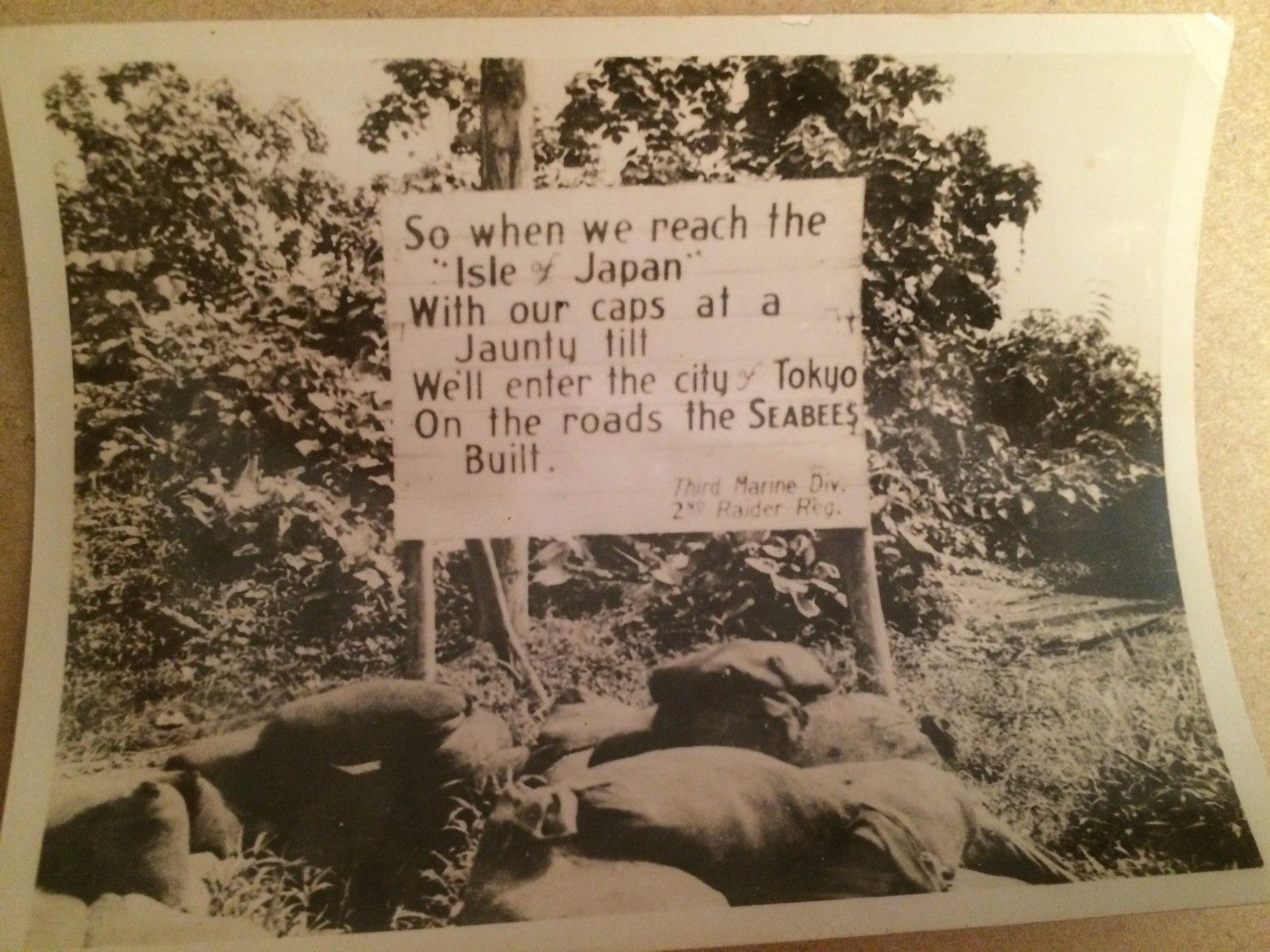
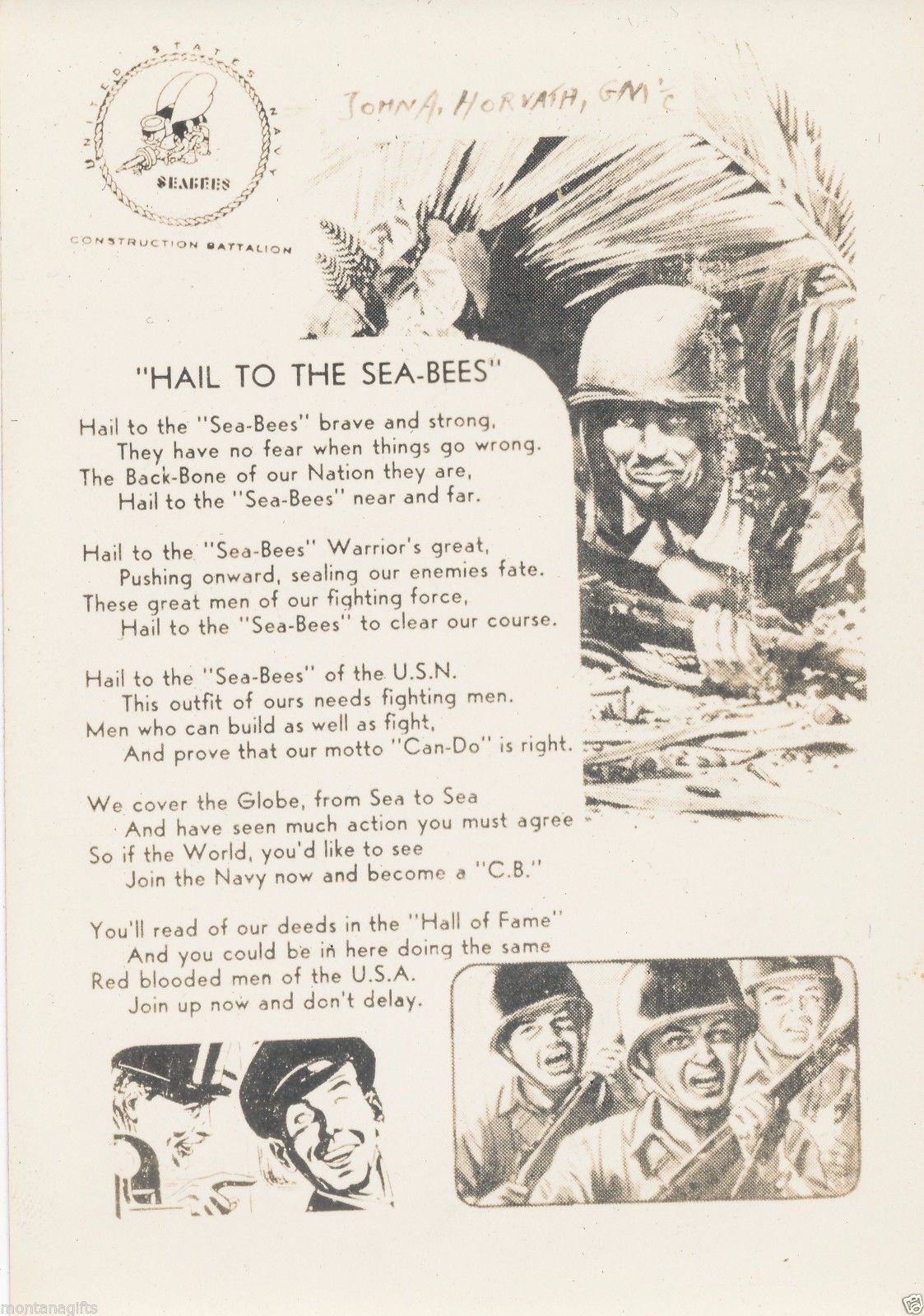
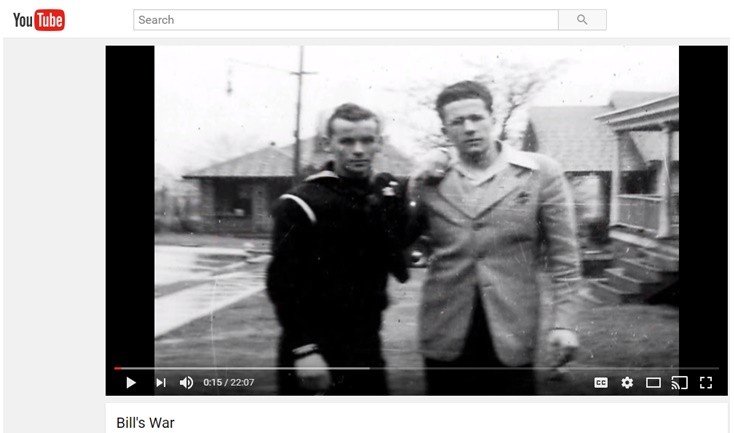

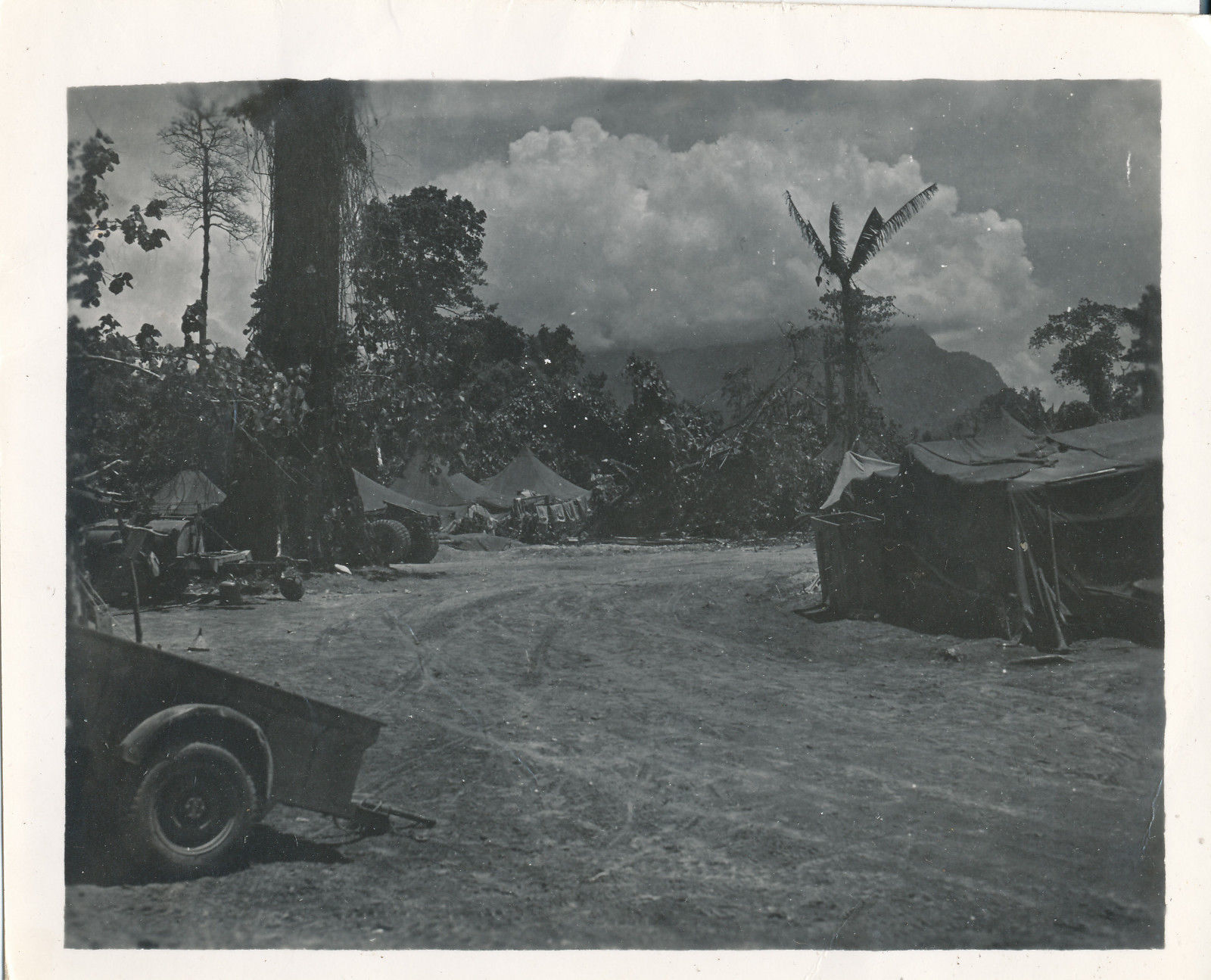

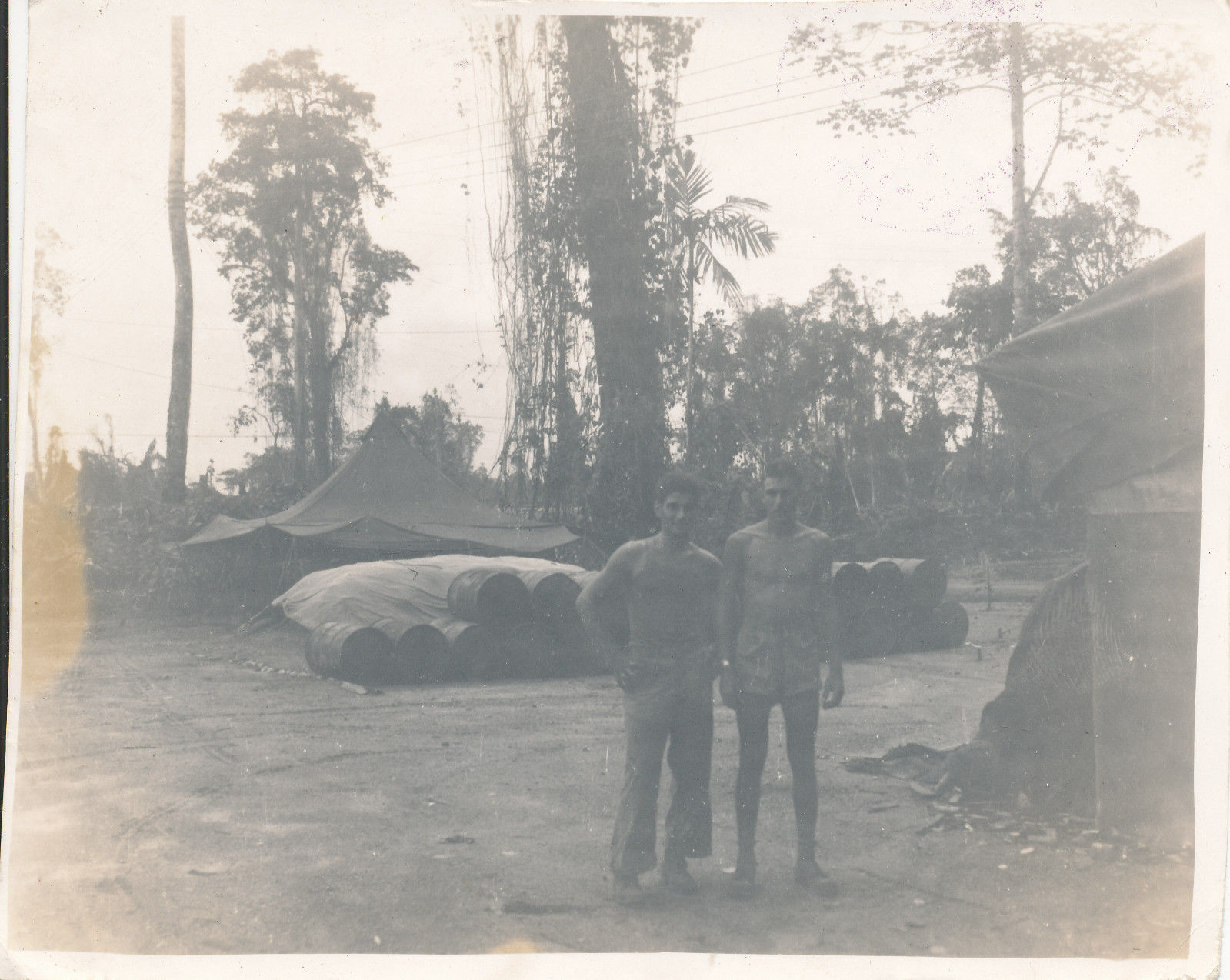
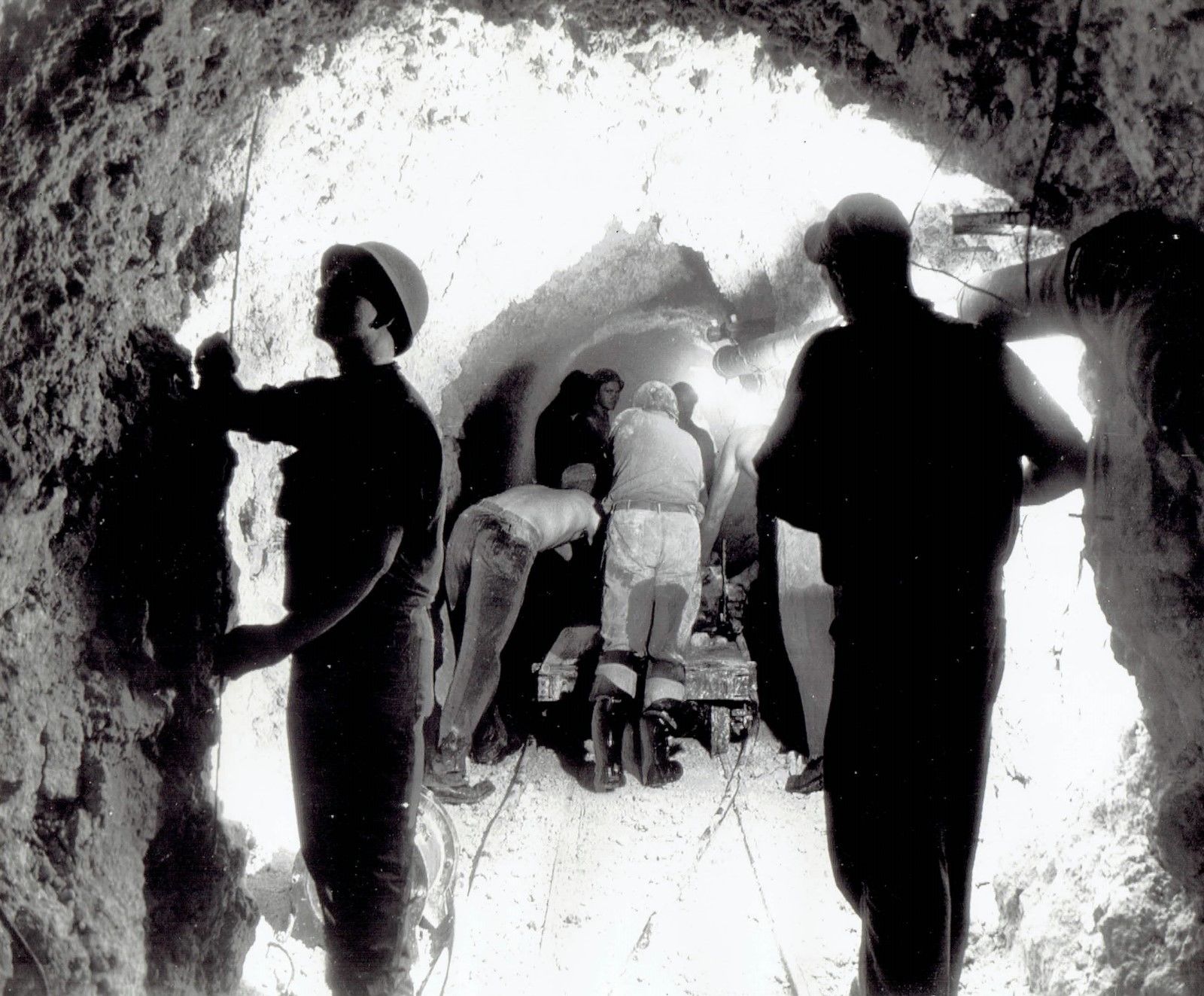
 The crawler-tractor on the left is an Allis-Chalmers
HD-7 pulling sheepfoot rollers. The crawler-tractor on the right is an
International TD-18 pulling a carryall. From left to right bottom photo: the
first three crawler-tractors are International TD-18's. Then there's three
Caterpillar D-8's. A International TD-18, the last one is a Caterpillar D-8.
All Carryalls are LeTourneau model "LS".This is grading on the fighter strip
on Bougainville. It is from the 77th history book. It states in the 77th
history book that the 53rd furnished most of the equipment for the job.
Looks like the 77th built most of the buildings for MAG 24 (Marine Aviation
Group).
The crawler-tractor on the left is an Allis-Chalmers
HD-7 pulling sheepfoot rollers. The crawler-tractor on the right is an
International TD-18 pulling a carryall. From left to right bottom photo: the
first three crawler-tractors are International TD-18's. Then there's three
Caterpillar D-8's. A International TD-18, the last one is a Caterpillar D-8.
All Carryalls are LeTourneau model "LS".This is grading on the fighter strip
on Bougainville. It is from the 77th history book. It states in the 77th
history book that the 53rd furnished most of the equipment for the job.
Looks like the 77th built most of the buildings for MAG 24 (Marine Aviation
Group).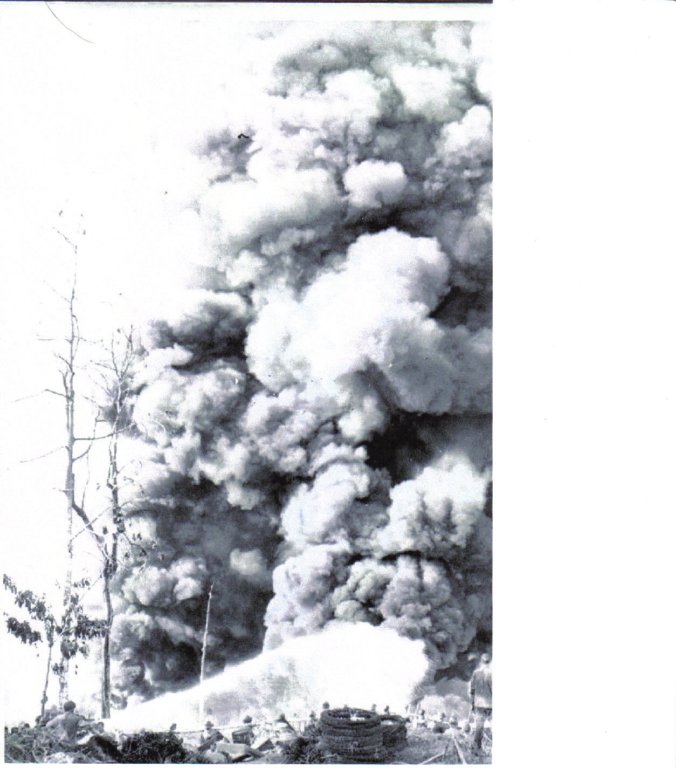 Jap
Bombers scored a direct hit on Gas & oil dump on Bougainville. 8,000 drums
were set on fire. Marines & Seabees battled the flames for 30 hours before
getting it under control.
Jap
Bombers scored a direct hit on Gas & oil dump on Bougainville. 8,000 drums
were set on fire. Marines & Seabees battled the flames for 30 hours before
getting it under control.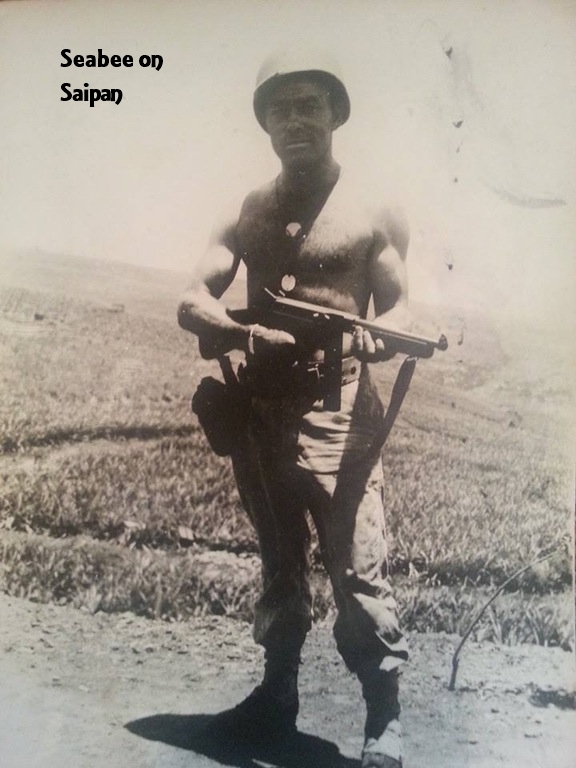
Stephen Cutting "A" Company was with us in
the ‘Nam. Steve has contributed numerous items for our web page. Steves’
parents have died and in going through items Steve came across letters
that his Dad had written home about the Pacific theater WW2. The letters
were written in cursive (will we be the last generation that can
write and read cursive??) and Steve has typed them up retaining the
misspellings, incorrect grammar, to retain the original flavor of these
communications, which follow:
Back to the days when Uncle Sam sent me to the South Seas. I had an
officer that was rather extraordinary. The Major - yes that was his
title was an army Major, detached from the Army and sent over to the
Navy as an officer in charge of the motor pool. (he was one of the 40
officers, and I was one of the 60 enlisted men). Anyway, this
occasion was down at the river, where my buddy Harry
and I were operating a bulldozer and drag-line. We would run one of them
for an hour and then trade off for the next hour, and we had a 3/4 yard
bucket on the drag line and loading dump trucks with gravel. Well, the
Major drove up as I was running the drag line, and having quite a time
with my right arm as I had a real sore one with Jungle rot half way
between the elbow and wrist. So the Major sat in his jeep and watched
for a while, then came over and told me to go sit in the jeep and he
would operate the drag line. He was doing really well, until our skipper
who was a full 4 striper, or Captain in the Navy. Well, the skipper
looked over and really flipped. There was the Major with no insignia on
- only a cut off pair of pants and shoes. He hollered at the Major --
told him to get off the drag-line -- put on a shirt -- and act like an
officer. The Major told him that I was not able to handle the drag line
until my arm healed up and for the skipper to get lost. That is when the
skipper flipped and told the Major to either obey his order or he would
court-marshal him -- and the Major laughed, and stated -- that would be
the day, that he was detached from the army and there was no way the
Navy was going to court-marshal an army officer. I did get a couple of
days rest, but other times were coming. Scroll forward a couple of
weeks, and around midnight I was awakened by the guard who told me to
get dressed and get over to the skipper's quarters as the skipper and
the major were about 4 sheets to the wind and wanted to see me. WELL --
I got there wondering what in the world had gone wrong -- where had I
slipped up -- and the Major told me that the skipper's boat had a broken
camshaft and there was none available. The boat with a broken engine was
no use to him, and he did enjoy water skiing (joke). I then asked the
skipper if I could use the other boat in the morning to go over to
Tulagi. It was about 20 miles over and the skipper told me NO!! There
was no camshaft over there. That is when the Major told him to let me
have the boat -- that their bet was still on, and if I did come back
with a camshaft that would be proof that the enlisted men could do
things that officers just couldn't do. Well -- I went over, got a
camshaft from a good friend, came back and there were the two
officers. When I gave the skipper the camshaft, the Major laughed and
told him he would make him a good officer yet. The Major was always
doing the unexpected, and we found out later that he had made a trip
back to the states for a week for some R and R. Of course it could have
been considered as AWOL, but him being an officer I guess he could get
away with it. We never did figure out what he and his wife used for an
explanation for her becoming pregnant during the week he was back in the
States. So. again scroll forward several months. I was in San Diego
again after getting back from overseas - and Astoria, and Santa Rosa,
and in January of 45 was in an outfit that had nothing but trouble. I
had asked for a transfer back to Astoria because my brother George was
back stateside and thought I was in Astoria. So when I asked for a
transfer I was told to forget it or I would be court-marshaled. WELL -
that got my dander up, so the next time I got a pass to go to town, I
went straight to North Island to the Commander of all Navy personnel on
the west coast. When I got to the office I asked to see the Captain and
was told No. Being the bashful type, I just walked into his office with
a shore patrolman right behind me and guess who the Captain
was? Yep, the same one I had obtained the camshaft for. He looked up
remembered my name and asked me to sit down and tell him what I had on
my mind. Well -- when I got back to the base I told the chief yeoman I
would be ready when the guard mail came. The chief himself came over
with my service jacket -- and orders transferring me to Astoria. He
also showed me the letter to be posted on the bulletin board which told
all enlisted men to indicate where they wished to be transferred to, and
all officers to report to North Island for immediate
transfer overseas. Seems that all the officers had seen of salt water
was down at the beach, and all enlisted men were overseas vets.


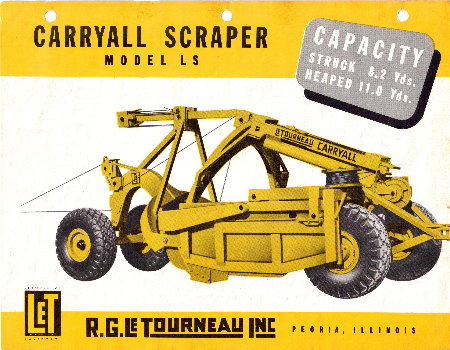 LeTourneau
started production on the LS and LP in 1940. They were the first carryalls
to have the "radius" A-arch. This was a vast improvement over the A-frame
carryalls (the A-frame would break; the A-arch would twist with
radial-torsion and not break). The LS was paired with Cat D7's (the Seabees
had very few of these, I've been told if you saw a Seabee a D7, you knew it
was stolen from the Army) International TD-18 and Allis-Chalmers HD-14 and
HD-10 and the Cat D8. The LP was paired mainly with the Cat D8 or sometimes
the Allis-Chalmers HD-14. By the way, the tractor carryall combination on
the front of the WWII Allis-Chalmers Service Manual is: HD-14 pulling a
GarWood carryall. The carryall was built by the world famous speed-boat
racer Garfield Wood! Check him out on the internet!
LeTourneau
started production on the LS and LP in 1940. They were the first carryalls
to have the "radius" A-arch. This was a vast improvement over the A-frame
carryalls (the A-frame would break; the A-arch would twist with
radial-torsion and not break). The LS was paired with Cat D7's (the Seabees
had very few of these, I've been told if you saw a Seabee a D7, you knew it
was stolen from the Army) International TD-18 and Allis-Chalmers HD-14 and
HD-10 and the Cat D8. The LP was paired mainly with the Cat D8 or sometimes
the Allis-Chalmers HD-14. By the way, the tractor carryall combination on
the front of the WWII Allis-Chalmers Service Manual is: HD-14 pulling a
GarWood carryall. The carryall was built by the world famous speed-boat
racer Garfield Wood! Check him out on the internet!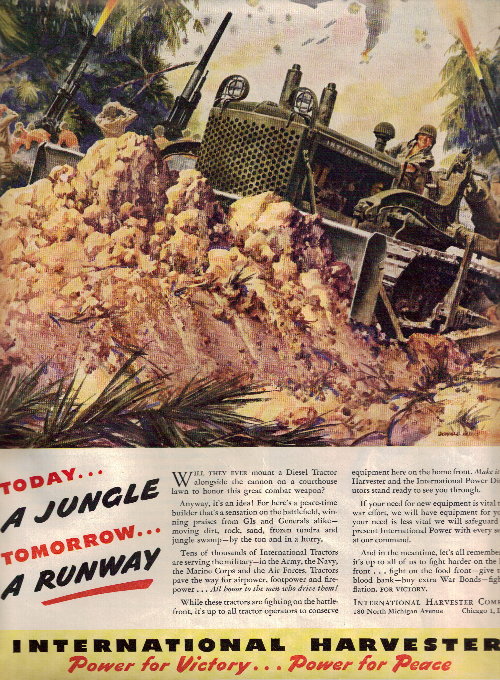

 WWII
Allis-Chalmers ad shows eight HD-14 crawler-tractors pulling GarWood
carryalls. There is also two HD-14 pusher tractors. That's one pusher
tractor to four tractor-carryalls.
WWII
Allis-Chalmers ad shows eight HD-14 crawler-tractors pulling GarWood
carryalls. There is also two HD-14 pusher tractors. That's one pusher
tractor to four tractor-carryalls.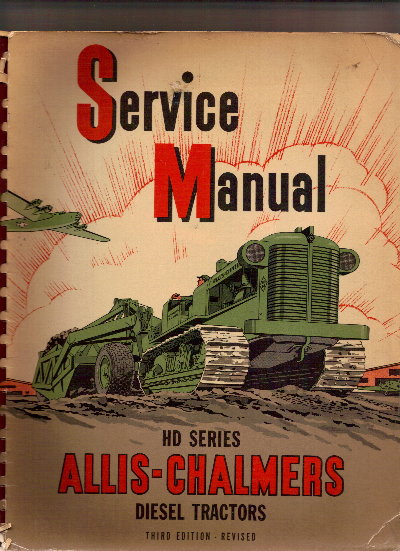

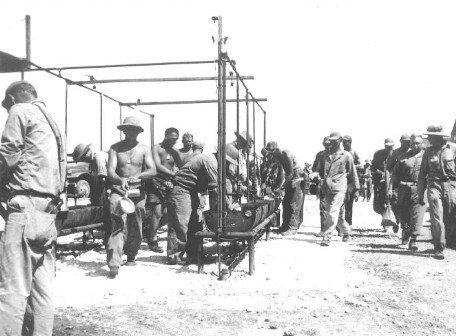
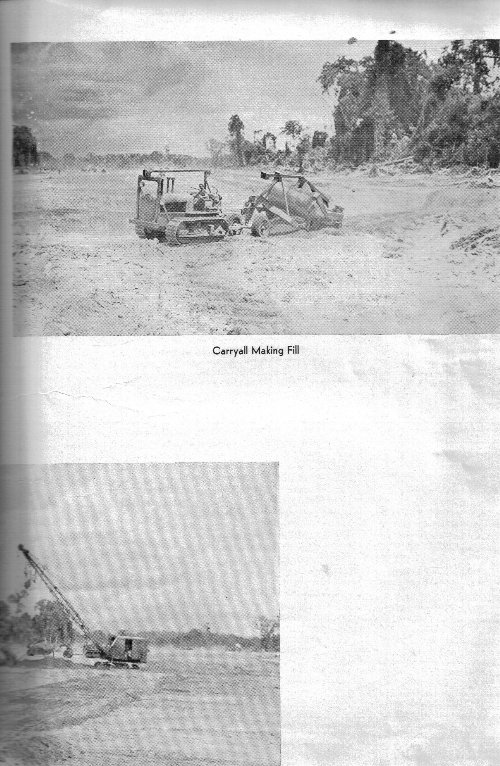 Top
picture is of an Allis-Chalmers HD-14 (the reinforcement strip welded to the
track frame determines the fact) pulling a LeTourneau model "LS" carryall.
Top
picture is of an Allis-Chalmers HD-14 (the reinforcement strip welded to the
track frame determines the fact) pulling a LeTourneau model "LS" carryall. How the airstrip was cleared on Bougainville. They put
two International TD-18 bulldozers side by side and cleared the airstrip
from the center of the width to the outside. This was done for the length of
the airstrip. When the clearing got real tough, they'd put another TD-18
behind, pushing the front one. At times there would be two in front and two
in back pushing. (I'd like to find a picture of that) This picture is of
two International TD-18 crawler-tractors with Bucyrus-Erie
bulldozers, working side by side on the fighter strip on Bougainville. It is
from the 77th history book.
How the airstrip was cleared on Bougainville. They put
two International TD-18 bulldozers side by side and cleared the airstrip
from the center of the width to the outside. This was done for the length of
the airstrip. When the clearing got real tough, they'd put another TD-18
behind, pushing the front one. At times there would be two in front and two
in back pushing. (I'd like to find a picture of that) This picture is of
two International TD-18 crawler-tractors with Bucyrus-Erie
bulldozers, working side by side on the fighter strip on Bougainville. It is
from the 77th history book.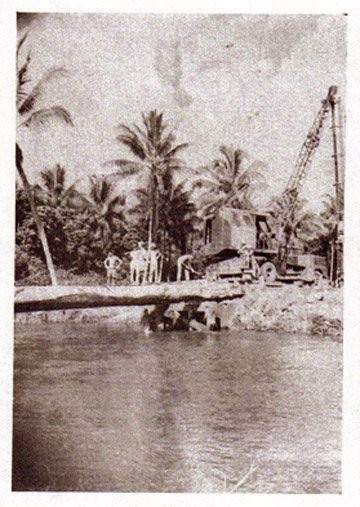
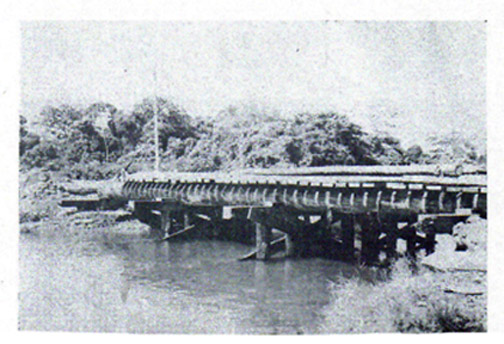
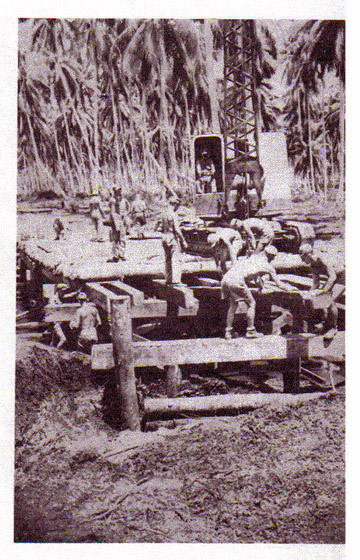
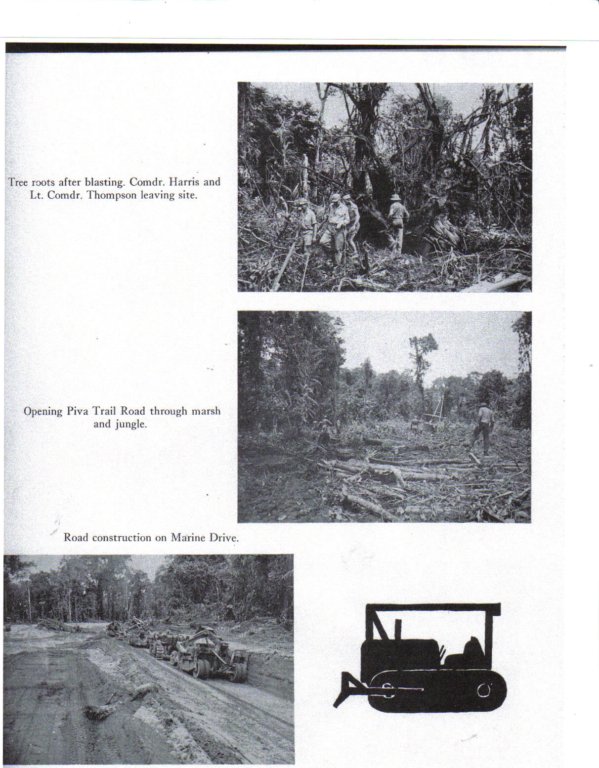


 UDT
- 3 "SEABEE DEMOLITION TEAM" Welcoming in the Marines at Guam. Look at the
date on the sign. 7-14-44. The invasion of Guam started on 7-21-44 ! They
were there seven days before the invasion.
UDT
- 3 "SEABEE DEMOLITION TEAM" Welcoming in the Marines at Guam. Look at the
date on the sign. 7-14-44. The invasion of Guam started on 7-21-44 ! They
were there seven days before the invasion.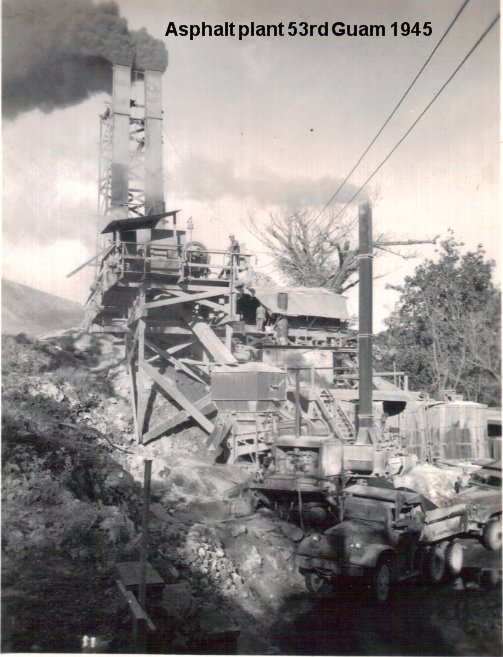


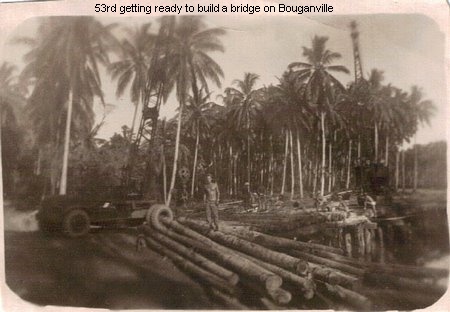
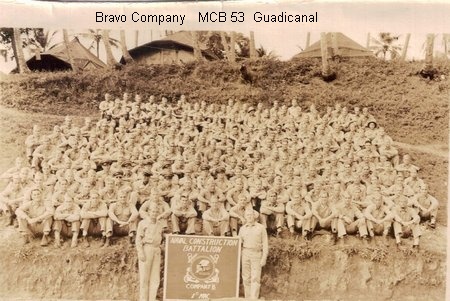

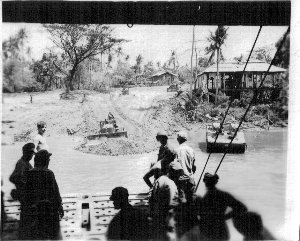 Inside
the LST looking at two D6's with angle blades pushing beach to the LST. One
International TD-18 of WWII era will out work a motor grader on beach
landings. The time it takes to move the same cubic yards will be the same.
The dozer pushes more yardage (even though the dozer has a slower travel
time) and the TD-18 will use 1/2 the amount of diesel fuel the motor grader
uses. Cost wise: TD-18, sand eats up steel tracks but 1/2 fuel cost, will
spin in the sand, no jerk to the final drives. Motor Grader, high fuel
cost! Over double the trips to move the same yardage. It spins in the sand
and wheel hops!! Big time jerk on the final drives! Very destructive on the
machine! $$$ The way people think changes, the earth don't. Mike
Baldwin
Inside
the LST looking at two D6's with angle blades pushing beach to the LST. One
International TD-18 of WWII era will out work a motor grader on beach
landings. The time it takes to move the same cubic yards will be the same.
The dozer pushes more yardage (even though the dozer has a slower travel
time) and the TD-18 will use 1/2 the amount of diesel fuel the motor grader
uses. Cost wise: TD-18, sand eats up steel tracks but 1/2 fuel cost, will
spin in the sand, no jerk to the final drives. Motor Grader, high fuel
cost! Over double the trips to move the same yardage. It spins in the sand
and wheel hops!! Big time jerk on the final drives! Very destructive on the
machine! $$$ The way people think changes, the earth don't. Mike
Baldwin

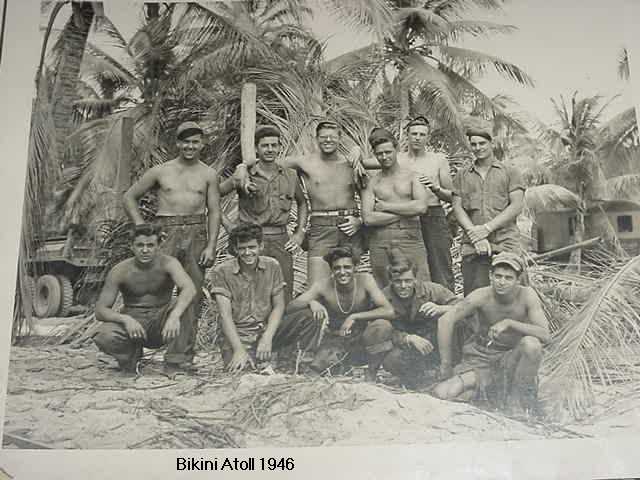

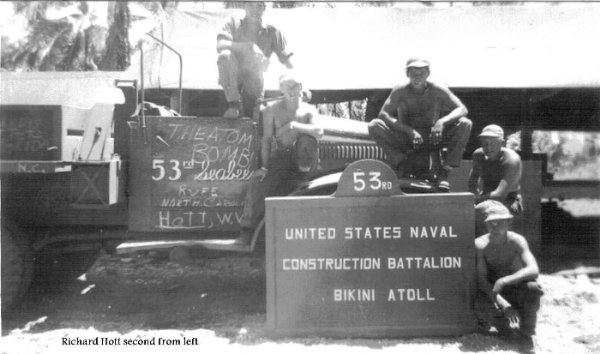
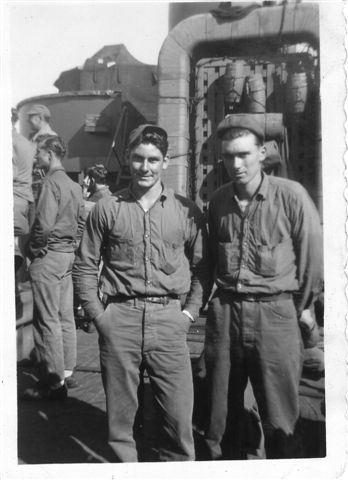 Jack
and Brown (first cousins)
Jack
and Brown (first cousins)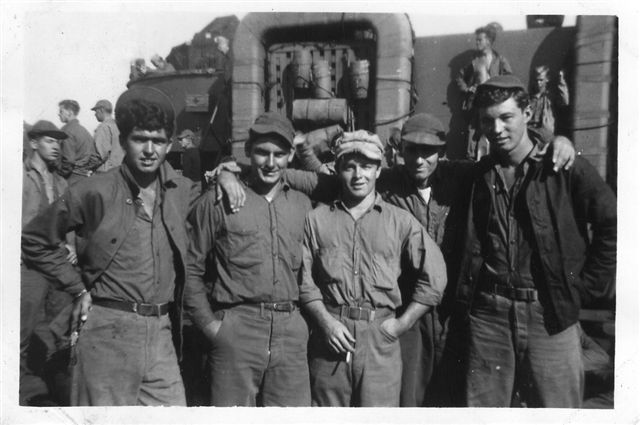 Reed,
Baldwin, Hott, Brown, Dix
Reed,
Baldwin, Hott, Brown, Dix On
Bikini Jack Baldwin on right, "Moose the Diver" next to him, then Simms
On
Bikini Jack Baldwin on right, "Moose the Diver" next to him, then Simms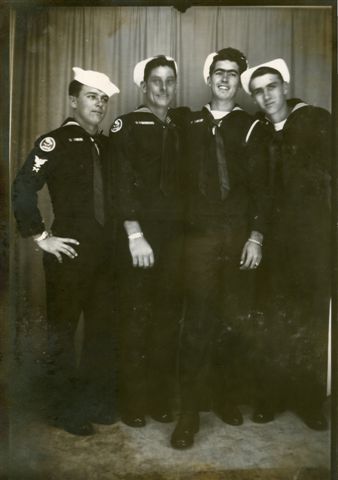 Coming
home Hott, Baldwin, Reed, Brown
Coming
home Hott, Baldwin, Reed, Brown 